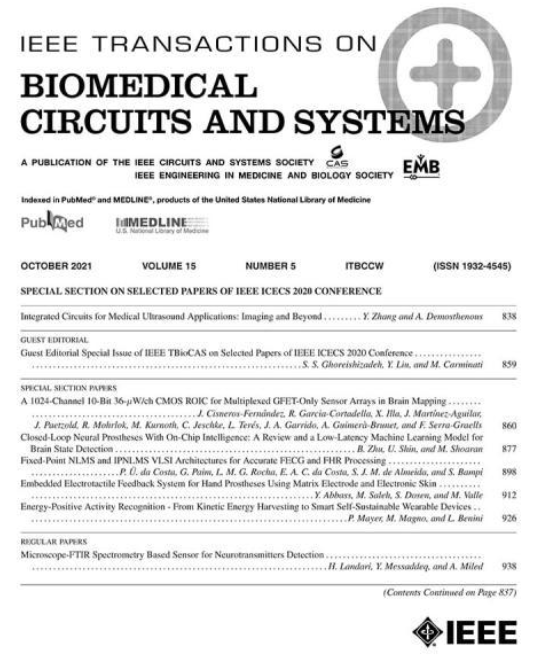片上系统对CMOS和流体生物接口异质集成的考虑。
IF 4.9
2区 医学
Q2 ENGINEERING, BIOMEDICAL
IEEE Transactions on Biomedical Circuits and Systems
Pub Date : 1900-01-01
DOI:10.1109/TBCAS.2016.2522402
引用次数: 6
摘要
CMOS芯片越来越多地用于流体和生物系统的直接传感和接口。虽然许多生物传感系统已经成功地将用于读出和信号处理的CMOS芯片与无源传感阵列相结合,但在单个芯片上与有源电路共同定位传感的系统在尺寸和性能上具有显着优势,但增加了多域设计和异构集成的复杂性。由于生物传感器和集成电路(ic)的不同要求,这种新兴的实验室cmos系统也提出了独特而令人烦恼的技术挑战。这些系统的建模不仅要考虑电路设计,还要考虑IC表面和任何物理结构上生物元件的行为。现有工具不支持异构实验室cmos系统的跨域仿真,因此我们建议采用两步建模方法:使用电路仿真来告知基于物理的仿真,反之亦然。我们回顾了cmos实验室实现的主要挑战,并讨论了克服这些挑战的实际方法。问题包括系统芯片集成中的经典挑战的新版本,例如热效应,地板规划和信号耦合,以及专门属于生物和流体领域的新挑战,例如电化学效应,非标准封装,表面处理,灭菌,表面结构的微制造和微流体集成。我们描述了这些问题,因为它们出现在实验室的cmos系统和讨论解决方案,已经实验证明。本文章由计算机程序翻译,如有差异,请以英文原文为准。
System-on-Chip Considerations for Heterogeneous Integration of CMOS and Fluidic Bio-Interfaces.
CMOS chips are increasingly used for direct sensing and interfacing with fluidic and biological systems. While many biosensing systems have successfully combined CMOS chips for readout and signal processing with passive sensing arrays, systems that co-locate sensing with active circuits on a single chip offer significant advantages in size and performance but increase the complexity of multi-domain design and heterogeneous integration. This emerging class of lab-on-CMOS systems also poses distinct and vexing technical challenges that arise from the disparate requirements of biosensors and integrated circuits (ICs). Modeling these systems must address not only circuit design, but also the behavior of biological components on the surface of the IC and any physical structures. Existing tools do not support the cross-domain simulation of heterogeneous lab-on-CMOS systems, so we recommend a two-step modeling approach: using circuit simulation to inform physics-based simulation, and vice versa. We review the primary lab-on-CMOS implementation challenges and discuss practical approaches to overcome them. Issues include new versions of classical challenges in system-on-chip integration, such as thermal effects, floor-planning, and signal coupling, as well as new challenges that are specifically attributable to biological and fluidic domains, such as electrochemical effects, non-standard packaging, surface treatments, sterilization, microfabrication of surface structures, and microfluidic integration. We describe these concerns as they arise in lab-on-CMOS systems and discuss solutions that have been experimentally demonstrated.
求助全文
通过发布文献求助,成功后即可免费获取论文全文。
去求助
来源期刊

IEEE Transactions on Biomedical Circuits and Systems
工程技术-工程:电子与电气
CiteScore
10.00
自引率
13.70%
发文量
174
审稿时长
3 months
期刊介绍:
The IEEE Transactions on Biomedical Circuits and Systems addresses areas at the crossroads of Circuits and Systems and Life Sciences. The main emphasis is on microelectronic issues in a wide range of applications found in life sciences, physical sciences and engineering. The primary goal of the journal is to bridge the unique scientific and technical activities of the Circuits and Systems Society to a wide variety of related areas such as: • Bioelectronics • Implantable and wearable electronics like cochlear and retinal prosthesis, motor control, etc. • Biotechnology sensor circuits, integrated systems, and networks • Micropower imaging technology • BioMEMS • Lab-on-chip Bio-nanotechnology • Organic Semiconductors • Biomedical Engineering • Genomics and Proteomics • Neuromorphic Engineering • Smart sensors • Low power micro- and nanoelectronics • Mixed-mode system-on-chip • Wireless technology • Gene circuits and molecular circuits • System biology • Brain science and engineering: such as neuro-informatics, neural prosthesis, cognitive engineering, brain computer interface • Healthcare: information technology for biomedical, epidemiology, and other related life science applications. General, theoretical, and application-oriented papers in the abovementioned technical areas with a Circuits and Systems perspective are encouraged to publish in TBioCAS. Of special interest are biomedical-oriented papers with a Circuits and Systems angle.
 求助内容:
求助内容: 应助结果提醒方式:
应助结果提醒方式:


